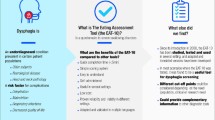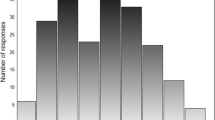Abstract
Early and reliable screening for oropharyngeal dysphagia (OD) symptoms in at-risk populations is important and a crucial first stage in effective OD management. The Eating Assessment Tool (EAT-10) is a commonly utilized screening and outcome measure. To date, studies using classic test theory methodologies report good psychometric properties, but the EAT-10 has not been evaluated using item response theory (e.g., Rasch analysis). The aim of this multisite study was to evaluate the internal consistency and structural validity and conduct a preliminary investigation of the cross-cultural validity of the EAT-10; floor and ceiling effects were also checked. Participants involved 636 patients deemed at risk of OD, from outpatient clinics in Spain, Turkey, Sweden, and Italy. The EAT-10 and videofluoroscopic and/or fiberoptic endoscopic evaluation of swallowing were used to confirm OD diagnosis. Patients with esophageal dysphagia were excluded to ensure a homogenous sample. Rasch analysis was used to investigate person and item fit statistics, response scale, dimensionality of the scale, differential item functioning (DIF), and floor and ceiling effect. The results indicate that the EAT-10 has significant weaknesses in structural validity and internal consistency. There are both item redundancy and lack of easy and difficult items. The thresholds of the rating scale categories were disordered and gender, confirmed OD, and language, and comorbid diagnosis showed DIF on a number of items. DIF analysis of language showed preliminary evidence of problems with cross-cultural validation, and the measure showed a clear floor effect. The authors recommend redevelopment of the EAT-10 using Rasch analysis.


Similar content being viewed by others
References
Rofes L, Arreola V, Mukherjee R, Clavé P. Sensitivity and specificity of the Eating Assessment Tool and the Volume–Viscosity Swallow Test for clinical evaluation of oropharyngeal dysphagia. Neurogastroenterol Motil. 2014;26(9):1256–65.
Sharma J, Fletcher S, Vassallo M, Ross I. What influences outcome of stroke—pyrexia or dysphagia? Int J Clin Pract. 2000;55(1):17–20.
Timmerman AA, Speyer R, Heijnen BJ, Klijn-Zwijnenberg IR. Psychometric characteristics of health-related quality-of-life questionnaires in oropharyngeal dysphagia. Dysphagia. 2014;29(2):183–98. doi:10.1007/s00455-013-9511-8.
Ekberg O, Hamdy S, Woisard V, Wuttge-Hannig A, Ortega P. Social and psychological burden of dysphagia: its impact on diagnosis and treatment. Dysphagia. 2002;17(2):139–46.
Stringer S. Managing dysphagia in palliative care. Prof Nurse. 1999;14(7):489–92.
Kertscher B, Speyer R, Fong E, Georgiou AM, Smith M. Prevalence of oropharyngeal dysphagia in the Netherlands: a telephone survey. Dysphagia. 2015;30(2):114–20.
Takizawa C, Kenworthy J, Gemmell E, Speyer R (under review) Oropharyngeal dysphagia in stroke, Parkinson’s disease, head injury, community acquired pneumonia, and Alzheimer’s disease: a systematic review. Cerebrovascular Diseases.
Perry L, Love CP. Screening for dysphagia and aspiration in acute stroke: a systematic review. Dysphagia. 2001;16(1):7–18.
Speyer R. Oropharyngeal dysphagia: screening and assessment. Otolaryngol Clin N Am. 2013;46(6):989–1008.
Cordier R, Speyer R, Chen Y, Wiles-Gillan S, Brown T, Bourke-Taylor H, Doma K, Leicht A. Evaluating the psychometric quality of social skills measures: a systematic review. PLoS ONE. 2015;10(7):e0132299.
Vaz S, Cordier R, Falkmer M, Ciccarelli M, Parsons P, McAuliffe T, Falkmer T. Should schools expect poor physical and mental health, social adjustment, and participation outcomes in students with disability? PLoS ONE. 2015;10(5):e0126630. doi:10.1371/journal.pone.0126630.
Liamputtong P. Research methods in health: foundation for evidence-based practice. 2nd ed. South Melbourne: Oxford University Press; 2013.
Speyer R, Cordier R, Kertscher B, Heijnen BJ. Psychometric properties of questionnaires on functional health status in oropharyngeal dysphagia: a systematic literature review. BioMed Res Int. 2014. doi:10.1155/2014/458678.
Ferrans CE, Zerwic JJ, Wilbur JE, Larson JL. Conceptual model of health-related quality of life. J Nurs Scholarsh. 2005;37(4):336–42.
Wilson IB, Cleary PD. Linking clinical variables with health-related quality of life: a conceptual model of patient outcomes. J Am Med Assoc. 1995;273(1):59–65.
Higginson I, Carr A. Using quality of life measures in the clinical setting. Br Med J. 2001;322(7297):1297–300.
Centers for disease control and prevention. Health-related quality of life (HRQOL). 2011. http://www.cdc.gov/hrqol/index.htm. Accessed Oct 2015.
Linacre JM. A user’s guide to W i n s t e p s® Rasch-model computer programs: program manual 3.92.0. Chicago: Mesa-Press; 2016.
Belafsky PC, Mouadeb DA, Rees CJ, Pryor JC, Postma GN, Allen J, Leonard RJ. Validity and reliability of the Eating Assessment Tool (EAT-10). Ann Otol Rhinol Laryngol. 2008;117(12):919–24.
Farahat M, Mesallam TA. Validation and cultural adaptation of the Arabic version of the Eating Assessment tool (EAT-10). Folia Phoniatr Logop. 2016;67(5):231–7.
Giraldo-Cadavid LF, Gutiérrez-Achury AM, Ruales-Suárez K, Rengifo-Varona ML, Barros C, Posada A, Romero C, Galvis AM. Validation of the Spanish version of the Eating Assessment Tool-10 (EAT-10spa) in Columbia. A blinded prospective cohort study. Dysphagia. 2015;. doi:10.1007/s00455-016-9690-1.
Mokkink LB, Terwee CB, Patrick DL, Alonso J, Stratford PW, Knol DL, Bouter LM, de Vet HC. The COSMIN study reached international consensus on taxonomy, terminology, and definitions of measurement properties for health-related patient-reported outcomes. J Clin Epidemiol. 2010;63(7):737–45.
Hambleton KH, Jones RW. An NCME instructional module on: comparison of classical test theory and item response theory and their applications to test development. Educ Meas. 1993;12(3):38–47.
Linacre JM. WINSTEPS Rasch measurement computer program: version 3.92.0. Chicago: Winsteps; 2016.
Bond TG, Fox CM. Applying the Rasch model: fundamental measurment in the human sciences. 3rd ed. New York: Taylor & Francis; 2015.
Linacre JM. Investigating rating scale category utility. J Outcome Meas. 1999;3(2):103–22.
Smith EVJ. Detecting and evaluating the impact of multidimensionality using item fit statistics and principal component analysis of residuals. In: Smith EVJ, editor. Introduction to Rasch measurement. Maple grove: JAM press; 2004. p. 93–122.
Terwee CB, Bot SD, de Boer MR, van der Windt DA, Knol DL, Dekker J, Bouter LM, de Vet HCW. Quality criteria were proposed for measurement properties of health status questionnaires. J Clin Epidemiol. 2007;60(1):34–42.
Burgos R, Sarto B, Segurola H, Romagosa A, Puiggrós C, Vázquez C, Cárdenas G, Barcons N, Araujo K, Pérez-Portabella C. Translation and validation of the Spanish version of the EAT-10 (Eating Assessment Tool-10) for the screening of dysphagia. Nutr Hosp. 2012;27(6):2048–55.
Rebelo Gonҫalves MI, Bogossian Remaili C, Behlau M. Cross-cultural adaptation of the Brazilian version of the Eating Assessment tool-EAT-10. CoDAS. 2013;25(6):601–4.
Schindler A, Mozzanica F, Monzani A, Ceriani E, Atac M, Jukic-Peladic N, Venturini C, Orlandoni P. Reliability and validity of the Italian Eating Assessment Tool. Ann Otol Rhinol Laryngol. 2013;122(11):717–24.
Santos Nogueira D, Lopes Ferreira P, Azevedo Reis E, Sousa Lopes I. Measuring outcomes for dysphagia: validity and reliability of the European Portuguese Eating Assessment Tool (P-EAT-10). Dysphagia. 2015;30:511–20.
Mokkink LB, Terwee CB, Knol DL, Stratford PW, Alonso J, Patrick DL, Bouter LM, De Vet HC. The COSMIN checklist for evaluating the methodological quality of studies on measurement properties: a clarification of its content. BMC Med Res Methodol. 2010;10(1):22.
Schellingerhout JM, Verhagen AP, Heymans MW, Koes BW, de Vet HC, Terwee CB. Measurement properties of disease-specific questionnaires in patients with neck pain: a systematic review. Qual Life Res. 2012;21(4):659–70.
Speyer R, Kertscher B, Cordier R. Functional health status in oropharyngeal dysphagia. J Gastroenterol Hepatol Res. 2014;3(5):1043–8.
Reise SP, Henson JM. A discussion of modern versus traditional psychometrics as applied to personality assessment scales. J Personal Assess. 2003;81(2):93–103.
Acknowledgments
The authors express their gratitude to Cally Smith, Rebekah Totino, and Lauren Parsons for providing research assistant support.
Author information
Authors and Affiliations
Corresponding author
Ethics declarations
Conflict of interest
The authors report no conflict of interest.
Electronic supplementary material
Below is the link to the electronic supplementary material.
Rights and permissions
About this article
Cite this article
Cordier, R., Joosten, A., Clavé, P. et al. Evaluating the Psychometric Properties of the Eating Assessment Tool (EAT-10) Using Rasch Analysis. Dysphagia 32, 250–260 (2017). https://doi.org/10.1007/s00455-016-9754-2
Received:
Accepted:
Published:
Issue Date:
DOI: https://doi.org/10.1007/s00455-016-9754-2




